Acura RL 2000 3.5 Owner's Manual
Manufacturer: ACURA, Model Year: 2000, Model line: RL, Model: Acura RL 2000Pages: 330, PDF Size: 4.53 MB
Page 231 of 330
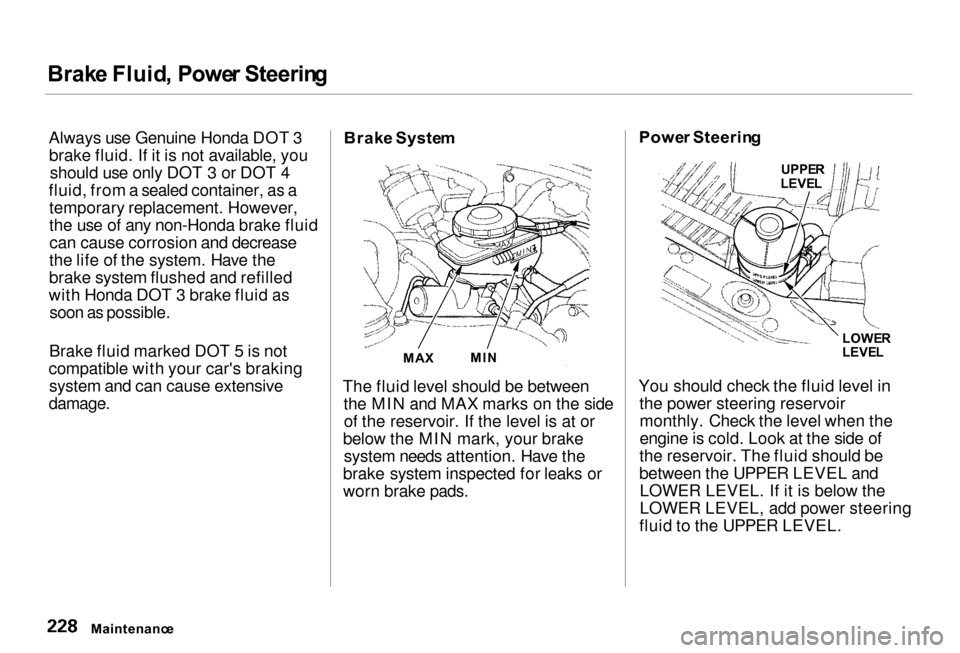
Brak
e Fluid , Powe r Steerin g
Always use Genuine Honda DOT 3 brake fluid. If it is not available, you should use only DOT 3 or DOT 4
fluid, from a sealed container, as a temporary replacement. However,
the use of any non-Honda brake fluidcan cause corrosion and decrease
the life of the system. Have the
brake system flushed and refilled
with Honda DOT 3 brake fluid as soon as possible.
Brake fluid marked DOT 5 is not
compatible with your car's braking system and can cause extensive
damage.
Brak
e Syste m
The fluid level should be between the MIN and MAX marks on the sideof the reservoir. If the level is at or
below the MIN mark, your brake system needs attention. Have the
brake system inspected for leaks or
worn brake pads. Powe
r Steerin g
You should check the fluid level in the power steering reservoirmonthly. Check the level when the
engine is cold. Look at the side of
the reservoir. The fluid should be
between the UPPER LEVEL and LOWER LEVEL. If it is below the
LOWER LEVEL, add power steering
fluid to the UPPER LEVEL.
Maintenanc e
MA
X MI
N LOWE
R
LEVE L
UPPE
R
LEVE L
Page 232 of 330

Powe
r Steering , Hoo d Latch , Ai r Cleane r Elemen t
Always use Genuine Honda Power Steering Fluid. If it is not available,
you may use another power steering fluid as an emergency replacement.However, continued use can causeincreased wear and poor steering in
cold weather. Have the powersteering system flushed and refilled
with Honda PSF as soon as possible.
A low power steering fluid level can indicate a leak in the system. Check
the fluid level frequently and have
the system inspected as soon as
possible.
Turning the steering wheel to full left
or right lock and holding it there can
damage the power steering pump.
Hoo d Latc h
Clean the hood latch assembly with a
mild cleaner, then lubricate it with a
multipurpose grease. Lubricate all
the moving parts (as shown),
including the pivot. Follow the time
and distance recommendations in
the Maintenance Schedule. If you are not sure how to clean and grease
the latch, contact your Acura dealer.
Ai
r Cleane r Elemen t
The air cleaner element should be cleaned or replaced according to the
time and distance recommendations
in the maintenance schedule.
Cleaning (Severe Conditions)
Clean the air cleaner element by
blowing compressed air through it in
the opposite direction to normal air
flow. If you do not have actcess to
compressed air (such as a service station), ask your Acura dealer to do
this service.
Follow the replacement procedure
for removal and reinstallation.
CONTINUED
Maintenanc e
PIVOT
S
LATC H
ASSEMBL Y
NOTIC E
Page 233 of 330
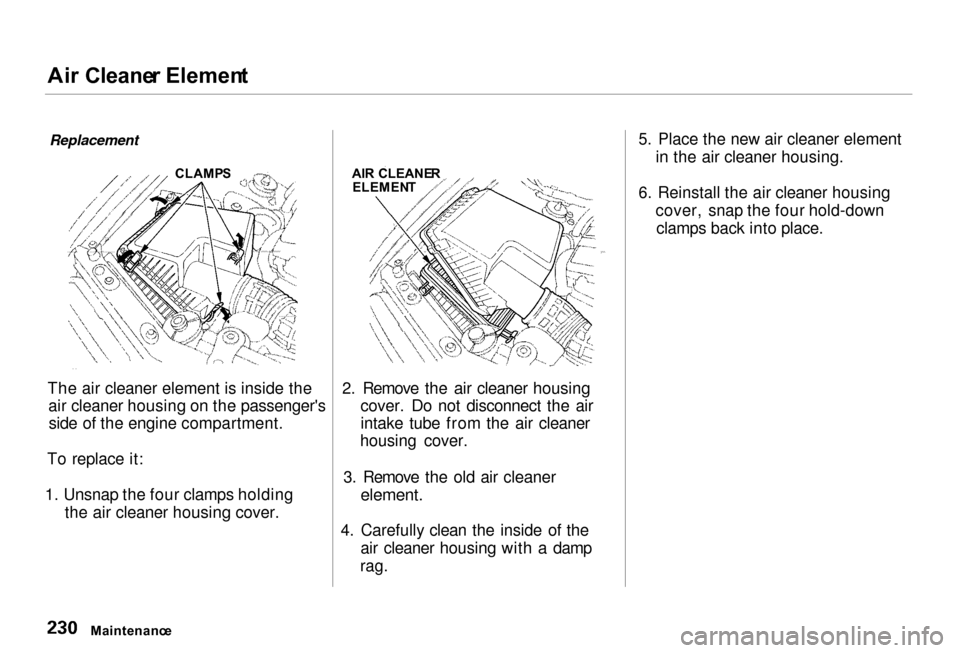
Ai
r Cleane r Elemen t
Replacement
The air cleaner element is inside the air cleaner housing on the passenger'sside of the engine compartment.
To replace it:
1. Unsnap the four clamps holding the air cleaner housing cover. 2. Remove the air cleaner housing
cover. Do not disconnect the air
intake tube from the air cleaner
housing cover.
3. Remove the old air cleaner
element.
4. Carefully clean the inside of the air cleaner housing with a damp
rag.
5. Place the new air cleaner element
in the air cleaner housing.
6. Reinstall the air cleaner housing cover, snap the four hold-downclamps back into place.
Maintenanc eCLAMP
S AIR CLEANE R
ELEMEN T
Page 234 of 330
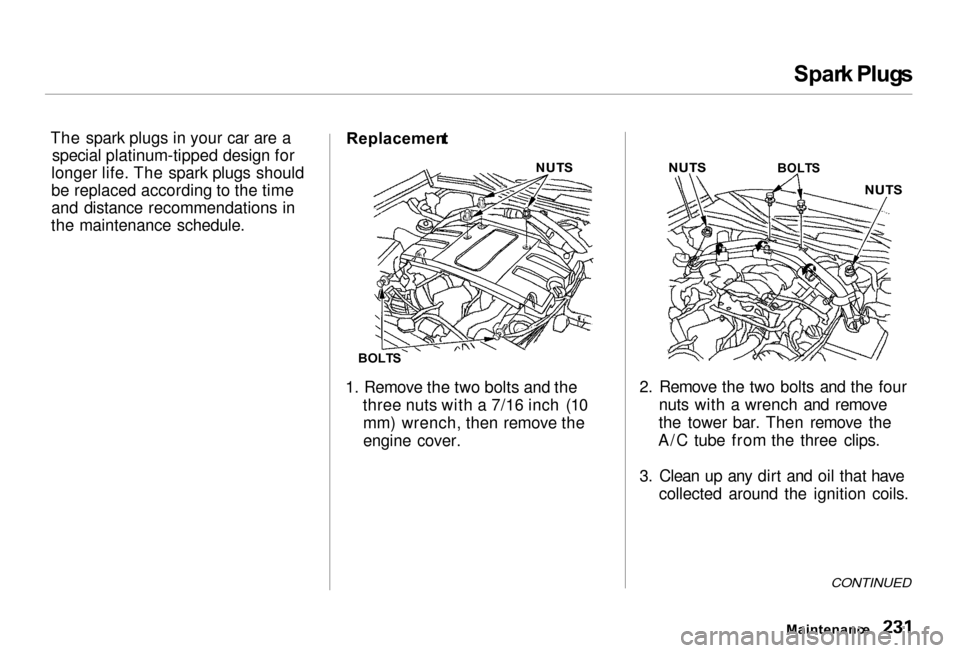
Spar
k Plug s
The spark plugs in your car are a special platinum-tipped design for
longer life. The spark plugs should
be replaced according to the time
and distance recommendations in
the maintenance schedule. Replacemen
t
1. Remove the two bolts and the three nuts with a 7/16 inch (10mm) wrench, then remove the
engine cover. 2. Remove the two bolts and the four
nuts with a wrench and remove
the tower bar. Then remove the
A/C tube from the three clips.
3. Clean up any dirt and oil that have collected around the ignition coils.
CONTINUED
Maintenanc e
NUT
S
BOLT S
NUT
S
BOLTS
NUTS
Page 235 of 330
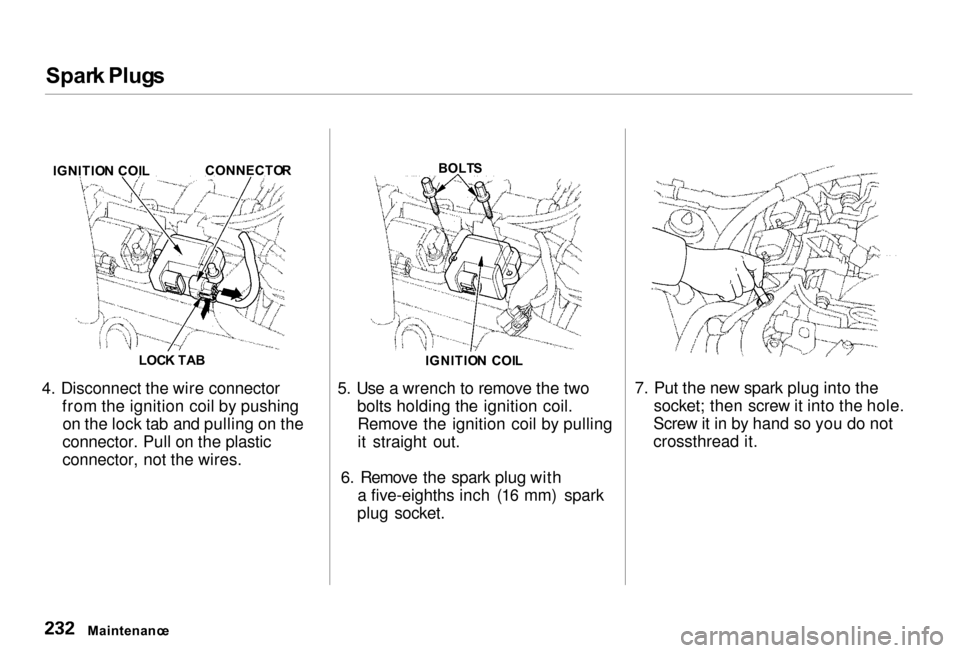
Spar
k Plug s
4. Disconnect the wire connector from the ignition coil by pushingon the lock tab and pulling on the
connector. Pull on the plastic
connector, not the wires. 5. Use a wrench to remove the two
bolts holding the ignition coil.Remove the ignition coil by pulling
it straight out.
6. Remove the spark plug with a five-eighths inch (16 mm) spark
plug socket. 7. Put the new spark plug into the
socket; then screw it into the hole.
Screw it in by hand so you do not
crossthread it.
Maintenanc e
IGNITIO
N COI L CONNECTO
R
LOC K TA B
BOLT
S
IGNITIO N COI L
Page 236 of 330
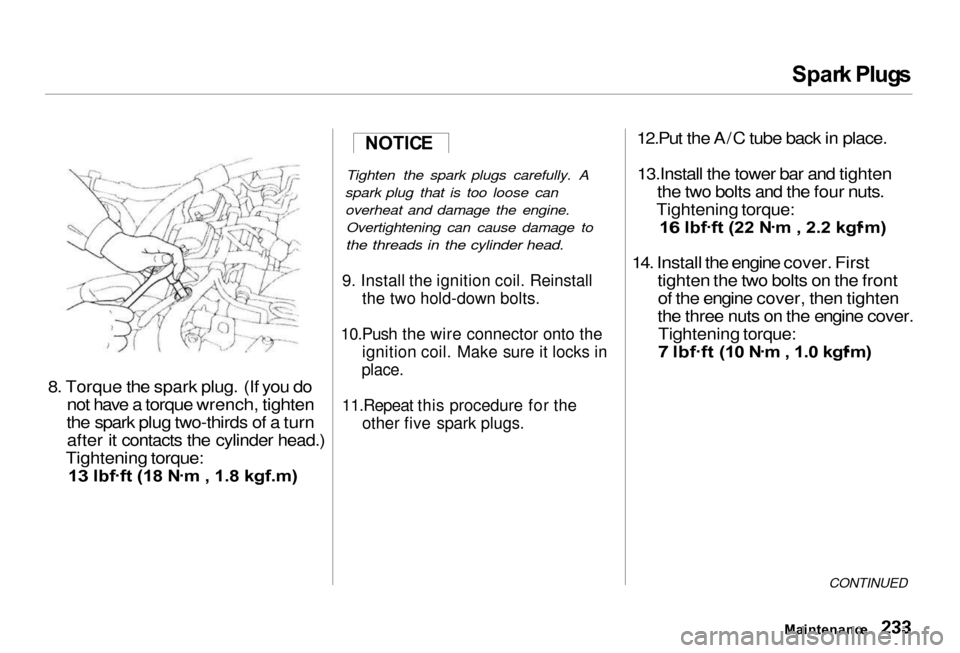
Spar
k Plug s
8. Torque th e spark plug . (If you do
not hav
e a torque wrench, tighten
the spark plug two-thirds of a turn after it contacts the cylinder head.)
Tightening torque:
13 lbf .
ft (18 N .
m , 1.8 kgf.m)
Tighten the spark plugs carefully. A
spark plug that is too loose can overheat and damage the engine. Overtightening can cause damage to
the threads in the cylinder head.
9. Install the ignition coil. Reinstall the two hold-down bolts.
10.Push the wire connector onto the ignition coil. Make sure it locks in
place.
11.Repeat this procedure for the other five spark plugs.
12.Put the A/C tube back in place.
13.Install the tower bar and tighten the two bolts and the four nuts.
Tightening torque:
16 lbf .
ft (22 N .
m , 2.2 kgf .
m)
14. Install the engine cover. First
tighten th e two bolts on the front
of the engine cover, then tighten
the three nuts on the engine cover.
Tightening torque:
7 lbf .
ft (10 N .
m , 1.0 kgf .
m)
CONTINUED
Maintenanc e
NOTIC
E
Page 237 of 330

Spar
k Plugs , Batter y
Specifications :
NGK:
DENSO:
PFR5L-1 1
PK16PR-L1 1
Spark Plug Gap:
0.043 in (1.1 mm )
Batter
y
Check the condition of your car's
battery monthly. You should check
the color of the test indicator window, and for corrosion on the terminals.
Check the battery condition by
looking at the test indicator window on the battery.
The label on the battery explains the test indicator's colors.
Maintenanc e TES
T INDICATO R WINDO W
Page 238 of 330

Batter
y
Check the battery terminals for
corrosion (a white or yellowish
powder). To remove it, cover the
terminals with a solution of baking
soda and water. It will bubble up and
turn brown. When this stops, wash it
off with plain water. Dry off the
battery with a cloth or paper towel. Coat the terminals with grease to
help prevent future corrosion.
If the terminals are severely cor-
roded, clean them with baking soda
and water. Then use a wrench to
loosen and remove the cables from the terminals. Always disconnect the
negative (
—) cable first and recon-
nect it last. Clean the battery termi-
nals with a terminal cleaning tool or
wire brush. Reconnect and tighten
the cables, then coat the terminals
with grease. If you need to connect the battery to
a charger, disconnect both cables to
prevent damage to the car's
electrical system.
CONTINUED
Maintenanc e
The battery gives off explosive
hydrogen gas during normal
operation.
A spark or flame can cause the battery to explode with enough
force to kill or seriously hurt you.
Wear protective clothing and a
face shield, or have a skilled mechanic do the battery
maintenance.
Page 239 of 330
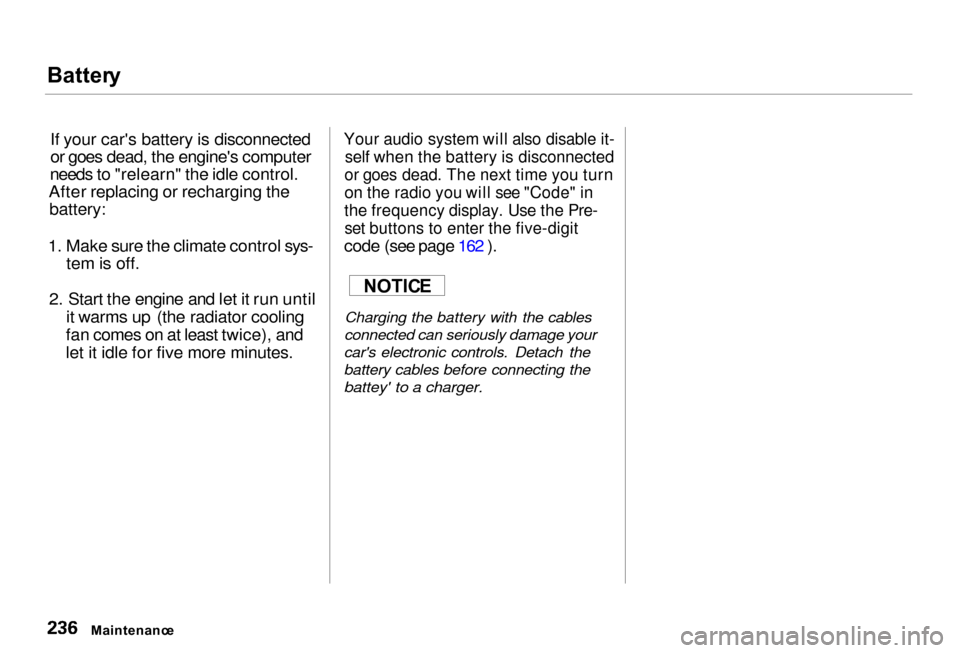
Batter
y
If your car's battery is disconnected
or goes dead, the engine's computer
needs to "relearn" the idle control.
After replacing or recharging the battery:
1. Make sure the climate control sys- tem is off.
2. Start the engine and let it run until it warms up (the radiator cooling
fan comes on at least twice), and
let it idle for five more minutes.
Your audio system will also disable it-
self when the battery is disconnected
or goes dead. The next time you turn
on the radio you will see "Code" in
the frequency display. Use the Pre-
set buttons to enter the five-digit
code (see page 162 ).
Charging the battery with the cables
connected can seriously damage your
car's electronic controls. Detach the
battery cables before connecting the
battey' to a charger.
Maintenanc e
NOTIC
E
Page 240 of 330
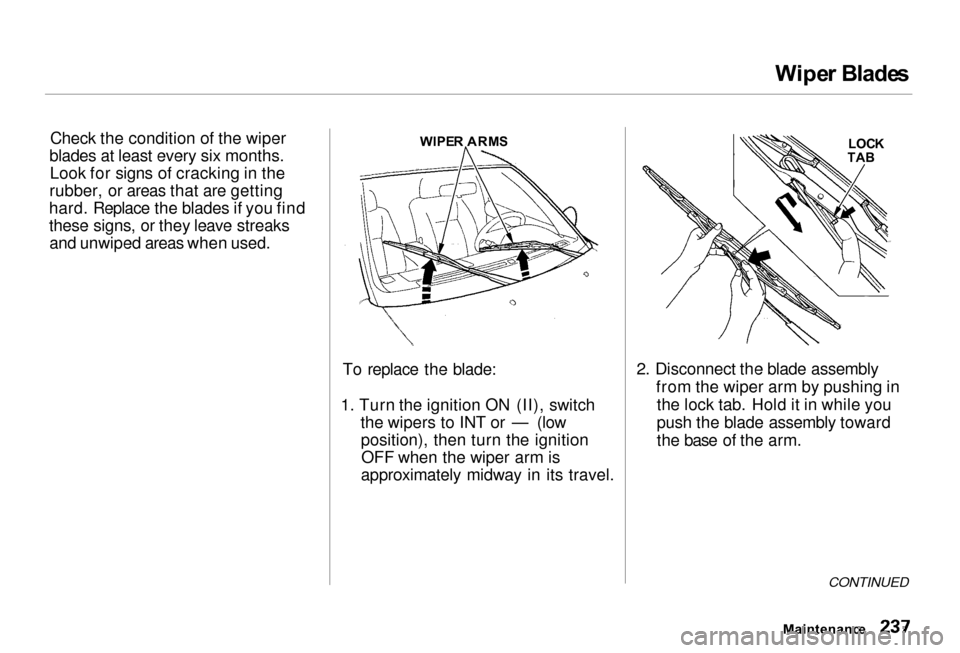
Wipe
r Blade s
Check the condition of the wiper
blades at least every six months. Look for signs of cracking in the
rubber, or areas that are getting
hard. Replace the blades if you find
these signs, or they leave streaks and unwiped areas when used.
To replace the blade:
1. Turn the ignition ON (II), switch the wipers to INT or — (lowposition), then turn the ignitionOFF when the wiper arm is
approximately midway in its travel. 2. Disconnect the blade assembly
from the wiper arm by pushing inthe lock tab. Hold it in while you
push the blade assembly toward
the base of the arm.
CONTINUED
Maintenanc e
WIPE
R ARM S
LOCK
TA B